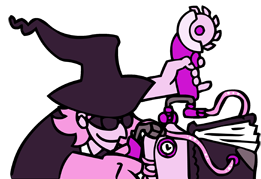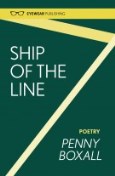reviewed by Judi Sutherland
A Cabinet of Curiosities
Penny Boxall’s reading from her forthcoming collection Ship of the Line was, for me, the standout event at last September’s Poetry Book Fair. Now the collection is here, and it lives up to the promise of that reading.
Boxall’s book is full of animals – only some of which are stuffed - bicycles, eminent historical characters, and the eponymous ships. Discovering that Boxall works at the Ashmolean Museum, in her adopted city of Oxford, makes perfect sense; this is a cabinet of curiosities worthy of the celebrated Pitt-Rivers, which happily also gets a namecheck in one of the poems. In most of the poems we are presented with an object or an animal, which Boxall uses to explore her themes of identity, duality and contrast.
The poet’s interests and wonderings are set out in front of us with philosophical intelligence and an eye for absurdity.
For a poet still under thirty, Boxall adopts quite a traditional style of formal stanzas. There’s even a sestina. She is engrossed by the odd, the quirky and the experimental, and her poems are full of insight and satisfying conclusions. Early in the collection, the poem ‘Williams, Who Lived’ conflates the history of three men, all called Hugh Williams, who each survived a shipwreck in successive centuries (thankfully there’s an explanatory note about this at the back of the book) as if the name were a talisman:
The parish registrars scrawled Williams upon Williams as though they kept forgetting. Williams married Susan, married Mary, married Anne; and when he died, (and died – and died - ) the headstones read the same, like yesterday’s paper.
Whatever else these men did in life, their names and shipwrecks define them for posterity. Boxall makes us consider the power of coincidence and the power of names.
There’s a delight in duality and reflections in this collection. Boxall explores a place that is neither here nor there in ‘Borderline’ - the celebrated Haskell Free Library and Opera House; a dual-purpose building that straddles the border between the United States and Canada. It belongs to neither and both countries and so, in the poem, at least, it burns down.
Duality recurs in ‘Two Ladies’; a poem inspired by the famous seventeenth century painting of the Cholmondley sisters, who, we are told in the epigram, were ‘born on the same day. Married on the same day, and brought to bed on the same day’. Boxall explores their parallel lives, beginning: ‘And they look like a halved egg / their twin shells frilled at the edge’. ‘From whose dark origin did the other split?’ she ponders, wondering where ‘self’ ends and ‘other’ begins. By the end of the poem, Boxall’s image remains in the gallery after she has left, and it also makes an appearance in ‘Follies’, where the poet catches her reflection in a train window:
I recognise the coat; it always takes a moment more to recognise myself.
Parallel images occur in a different way in ‘What came first’, where an egg in a nest, a child’s hand in a teacher’s hand and strawberries in a tart are topologically similar images of containment and protection used in the poem to discuss a death.
Boxall is also interested in work and life, and how a person might apply similar sensibilities in both. ‘Snowflake Bentley’ is about a man who photographed snowflakes and discovered that they were all different, but his obsessive research dismays his wife. She tells us: ‘the idea of our marriage formed and dissolved’. The wife worries that her sameness is no match for the infinite novelty of the snow. ‘Eadweard Muybridge’ celebrates another Victorian photographer; the man who worked out the sequence of the horse’s gallop from a series of still photographs. As in many poems, the collision of two facts sparks the poem to life. Muybridge also happened to shoot – with a gun, this time – his wife’s lover, and was acquitted of murder. The poem hinges on this image:
Did he see the bullet’s silver progress in beads of light that flashed inside his eyes in zoetrope succession?
It concludes, satisfyingly, with Muybridge filming bison in the Wild West:
They’re evidence enough that we can watch through gaps, and guess it right.
Throughout the poems, we find strong visual language that perfectly communicates the poet’s ideas. A soaked bee rescued from a swimming pool is ‘a tiny unmapped / island’. Clouds are ‘bursting white // like unstitched pillows’. Recalling a summer evening, the poet tells us: ‘the night is aswarm: winged prehistoric things / insist on our faces, searching for a hold’. Boxall’s visuals are elegant and accurate.
This feels like a first collection. All the poet’s interests and wonderings are set out in front of us, and they are varied, drawing on a series of disparate incidents. Boxall excels in ‘making the familiar strange’. She has a philosophical intelligence and an eye for absurdity. She carefully curates her most thought-provoking experiences and reading, and fills them with meaning; from cataloguing a collection of fabrics to accidentally swiping a bat during an evening tennis match. So many younger poets are preoccupied with relationships and with their place in the world. Boxall casts her net much wider than that; both her fascinating subject matter, and the thoughtful way she treats it, give this collection great charm and maturity. Like a good museum curator, Boxall holds each object up to the light and shows us its relevance with clarity and humour.
Judi Sutherland gained a PhD in Biochemistry before embarking on a career in pharma / biotech and started writing poems in 2008. After redundancy in 2011, she obtained an MA in Creative Writing from Royal Holloway, University of London, and is now writing a novel, as well as poetry, blogs and reviews. Her poems have been published in Acumen, Interpreter’s House, Oxford Poetry and New Statesman, among others. Her writing blog can be found at www.judisutherland.com and her Huffington Post articles are right this way.









